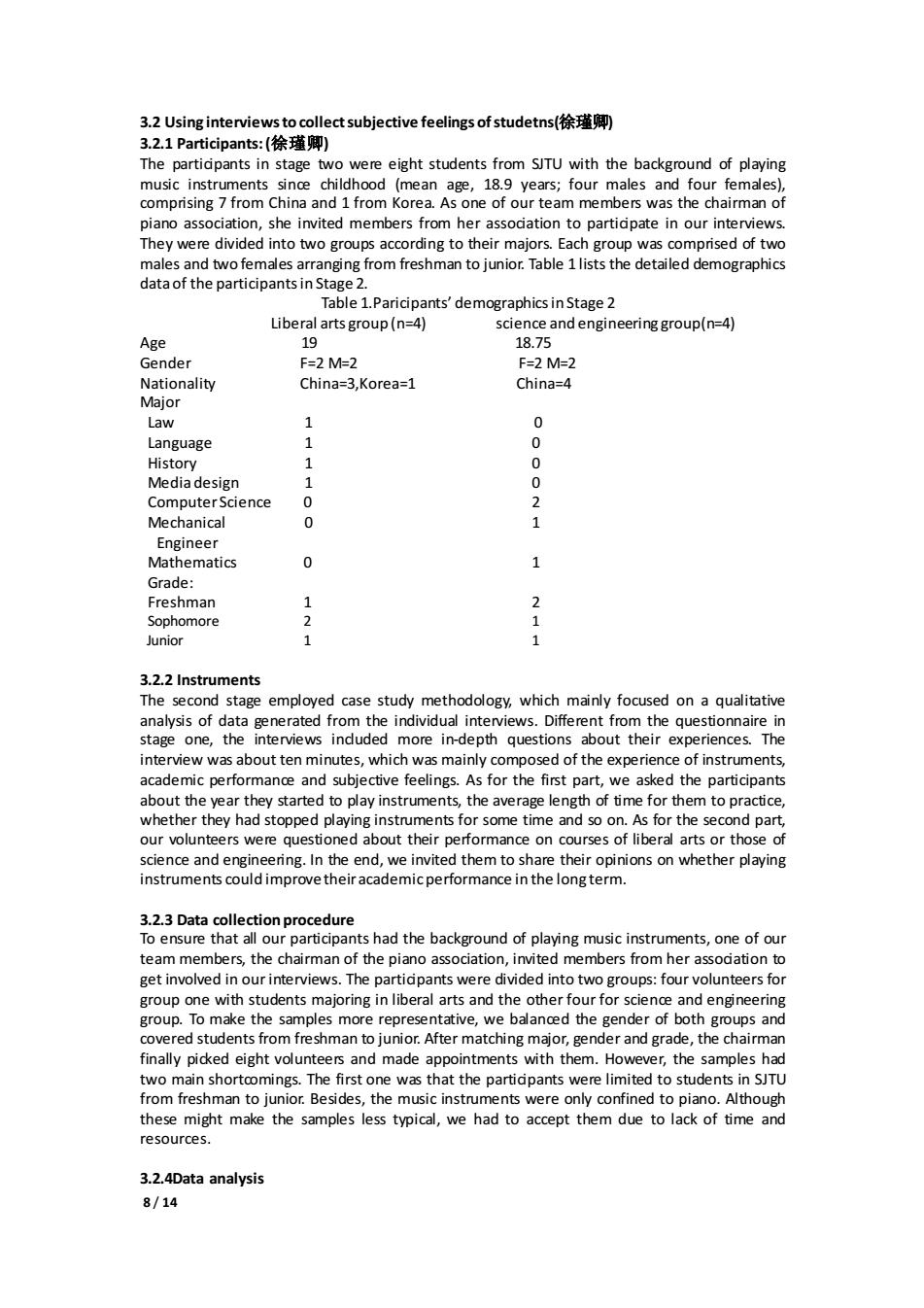正在加载图片...

3.2 Using interviews to collect subjective feelings of studetns(徐瑾卿 3.2.1 Participants:(徐瑾卿) The partiapants in stage two were eight students from SITU with the background of playing music instruments since childhood (mean age,18.9 years;four males and four females), comprising 7 from China and 1 from Korea.As one of our team members was the chairman of piano association,she invited members from her assocation to partiapate in our interviews. They were divided into two groups according to their majors.Each group was comprised of two males and two females arranging from freshman to junior.Table 1 lists the detailed demographics data of the participants in Stage 2. Table 1.Paricipants'demographics in Stage 2 Liberal arts group(n=4) science and engineering group(n=4) Age 19 18.75 Gender F=2M=2 F=2M=2 Nationality China=3,Korea=1 China=4 Major Law 1 0 Language 1 0 History 1 0 Media design 1 0 ComputerScience 0 Mechanical 0 Engineer Mathematics 0 Grade: Freshman 1 2 Sophomore 2 Junior 1 3.2.2 Instruments The second stage employed case study methodology,which mainly focused on a qualitative analysis of data generated from the individual interviews.Different from the questionnaire in stage one,the interviews induded more in-depth questions about their experiences.The interview was about ten minutes,which was mainly composed of the experience of instruments, academic performance and subjective feelings.As for the first part,we asked the participants about the year they started to play instruments,the average length of time for them to practice, whether they had stopped playing instruments for some time and so on.As for the second part, our volunteers were questioned about their performance on courses of liberal arts or those of science and engineering.In the end,we invited them to share their opinions on whether playing instruments could improve their academic performance in the long term. 3.2.3 Data collection procedure To ensure that all our participants had the background of playing music instruments,one of our team members,the chairman of the piano association,invited members from her assodation to get involved in our interviews.The partiapants were divided into two groups:four volunteers for group one with students majoring in liberal arts and the other four for science and engineering group.To make the samples more representative,we balanced the gender of both groups and covered students from freshman to junior.After matching major,gender and grade,the chairman finally picked eight volunteers and made appointments with them.However,the samples had two main shortoomings.The first one was that the partiapants were limited to students in SJTU from freshman to junior.Besides,the music instruments were only confined to piano.Although these might make the samples less typical,we had to accept them due to lack of time and resources. 3.2.4Data analysis 8/148 / 14 3.2 Using interviewstocollectsubjective feelings ofstudetns(徐瑾卿) 3.2.1 Participants:(徐瑾卿) The participants in stage two were eight students from SJTU with the background of playing music instruments since childhood (mean age, 18.9 years; four males and four females), comprising 7 from China and 1 from Korea. As one of our team members was the chairman of piano association, she invited members from her association to participate in our interviews. They were divided into two groups according to their majors. Each group was comprised of two males and two females arranging from freshman to junior. Table 1 lists the detailed demographics dataof the participantsin Stage 2. Table 1.Paricipants’ demographicsin Stage 2 Liberal arts group (n=4) science and engineering group(n=4) Age 19 18.75 Gender F=2 M=2 F=2 M=2 Nationality China=3,Korea=1 China=4 Major Law 1 0 Language 1 0 History 1 0 Mediadesign 1 0 Computer Science 0 2 Mechanical 0 1 Engineer Mathematics 0 1 Grade: Freshman 1 2 Sophomore 2 1 Junior 1 1 3.2.2 Instruments The second stage employed case study methodology, which mainly focused on a qualitative analysis of data generated from the individual interviews. Different from the questionnaire in stage one, the interviews included more in-depth questions about their experiences. The interview was about ten minutes, which was mainly composed of the experience of instruments, academic performance and subjective feelings. As for the first part, we asked the participants about the year they started to play instruments, the average length of time for them to practice, whether they had stopped playing instruments for some time and so on. As for the second part, our volunteers were questioned about their performance on courses of liberal arts or those of science and engineering. In the end, we invited them to share their opinions on whether playing instruments could improvetheir academicperformance in the long term. 3.2.3 Data collection procedure To ensure that all our participants had the background of playing music instruments, one of our team members, the chairman of the piano association, invited members from her association to get involved in our interviews. The participants were divided into two groups: four volunteers for group one with students majoring in liberal arts and the other four for science and engineering group. To make the samples more representative, we balanced the gender of both groups and covered students from freshman to junior. After matching major, gender and grade, the chairman finally picked eight volunteers and made appointments with them. However, the samples had two main shortcomings. The first one was that the participants were limited to students in SJTU from freshman to junior. Besides, the music instruments were only confined to piano. Although these might make the samples less typical, we had to accept them due to lack of time and resources. 3.2.4Data analysis